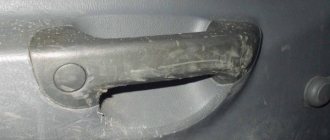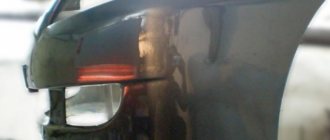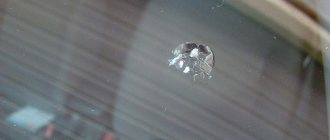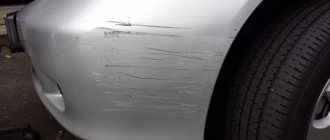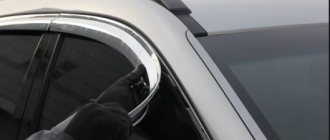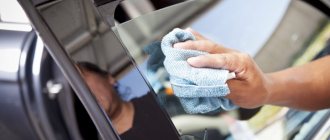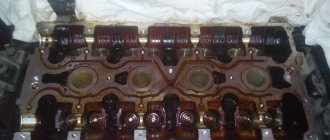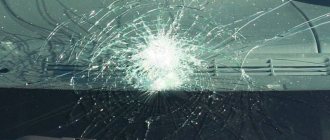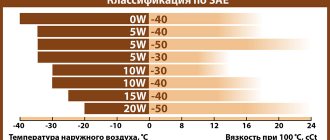Removing scratches with wiping towels
Ways to eliminate flaws:
- Lighter.
- Construction hairdryer.
- Wax pencils.
- Polishing.
- The overhaul is carried out in a professional workshop, the plastic is cleaned, primed, painted, and varnished.
External defects can be removed using a lighter; turbocharged products with high temperatures and stable combustion are best suited. The problem area is heating up, you can’t keep the fire in one area, the hand with the lighter is constantly moving.
The flame is not brought too close; a suitable distance is selected so that the part does not melt. The abrasions will heal slowly; in a heated area, the soft plastic should not be touched with your hands. This method is suitable for smooth plastic; the structure of the corrugated surface changes after heating. Instead of a lighter, you can use a hair dryer that generates high heat. Sometimes the power of the device is enough to dry your hair. Before use, remove dirt, dust, and allow automotive cleaning chemicals or dishwashing detergent.
The hair dryer is turned on at a low temperature; if deformation does not occur, the power increases. Small damages are reduced immediately and polished for a better appearance. Microfiber cleaning towels are sometimes used. This is an effective method, the problem area is actively rubbed, all minor defects are eliminated. Dirty rags are washed and reused many times.
Minor defects appear on the panels inside the machine. If they are not restored in time, abrasions will appear everywhere, creating a cobweb that will be more difficult to deal with. You have to go to a workshop; it’s difficult to get rid of the problem on your own.
Types of Damage
We remove chips and scratches on paintwork.
Small scratches are often found inside the car, intertwining into a web of damage. As a result, the appearance of the interior is spoiled, which requires the search for camouflage techniques. Knowing your options, you can remove defects in a short time with minimal financial costs.
More serious costs will be incurred if you have to repair deep damage, since many defects cannot be hidden using simple techniques. The following are the most common methods that will help remove unwanted scratches, thereby improving the appearance of your car's interior.
There are several options for scratching plastic in the car interior:
- Small cracks in the car formed when the material comes into contact with the driver’s keys and other personal belongings that come into contact with the panel.
- Deep large cracks that require a more detailed approach to their destruction.
- Scratches caused by the sun as a result of its action. The fact is that after radiation the surface becomes dull and loses its color.
The removal process is not always simple; major repairs of the products will be required.
Restoring the plastic of a car interior - methods and solutions
Each driver of his vehicle, in one way or another, tries to take care not only of the appearance of his iron horse, but also pays a lot of attention to the interior decoration - the interior of the car. As practice shows, not only leather interiors deteriorate under the pressure of daily trips to work and at least a couple of trips to the country house and to the store. The interior of a car is where we spend a lot of time, so it’s worth paying special attention to its condition. Many owners of cars with high mileage in this case prefer to contact special services, but in this article we will tell you how to restore the plastic of the car interior with your own hands.
How to remove scratches on interior plastic 4 methods to choose from
Renault Logan Silver Logbook 016 Replacing the air filter. TO1-1
- Minor scratches. Most often, they form a whole web, since they arise in places that are constantly exposed to the same type of influence. They will be the easiest to deal with, despite their abundance;
- Deep scratches or cuts. They can be found anywhere, as they are the result of rough physical contact with something sharp, but most often they appear on door trims as a result of loading a large item. They can be removed, although in more complex ways than defects of group 1;
- A combination of types 1 and 2 damage with the consequences of exposure to ultraviolet radiation. Naturally, the dashboard burns out. In combination with even minor scratches, the appearance is terrible and cannot be removed with home remedies.
- The area to be repaired is washed and dried;
- The hair dryer is turned on to minimum and directed towards the defect. There is no need to hold it at one point - move along the damage not quickly, but not too slowly.
- The surface is cleaned again with water and detergent and dried - dirt that has accumulated in the defects will not allow them to heal well;
- The paste is applied to the damage using a soft dishwasher or foam rubber;
- Wait the time indicated on the package - usually about 5 minutes. The signal that you are ready for polishing will be the formation of a whitish coating;
- It is better to polish by hand: there are not many plastic surfaces in the interior, and the strong heat of a sander can damage them beyond repair.
AutoFlit.ru
How do reducing agents work?
Plastic restorers work in the same way as most polishes designed to care for the paintwork of a car body. Thanks to the composition, the active components penetrate deep into the microrelief of the plastic surface, leveling it.
After processing, the sun's rays falling on the plastic are reflected by the collected beam, providing the effect of surface integrity. In fact, such cosmetics do not restore the internal structure of plastic. They provide a purely cosmetic effect.
The composition of such car cosmetics includes various components. It can be based on petroleum products, wax or glycerin. Despite such diversity, the effect of using various means is not very different.
This mainly concerns durability, reliability of protection from external influences, intensity of shine or depth of matte. After treatment, the plastic surface regains its original appearance, and abrasions and scratches are ideally masked.
How to remove a small scratch from plastic
Polishing plastic from scratches
The first two methods are suitable for very minor damage. In the first case, the surface is heated. Using a hairdryer is, of course, safer. An open flame near plastic creates the preconditions for a fire. A hairdryer can be both household and construction. You should not direct the hot jet to one place; you need to heat the entire surface very gradually so as not to melt the part.
If you decide to use a lighter, you need to purchase a so-called turbo lighter. It is easily identified by the blue color of the flame. It's best to first practice on some plastic object that you don't mind throwing away
Act quickly and carefully, don't burn a hole
The method is based on the ability of heated plastic to soften and heal minor damage. Never touch hot material unless you want to leave fingerprints or completely deform the part. Such damage cannot be repaired.
The second method is reminiscent of regular kitchen cleaning. Special towels and napkins are made from polymer microfiber. This type of fabric is called microfiber and is used in a variety of cleaning products. Your favorite car is no different from a kitchen item. Any car owner who wants to keep their car clean should have a set of towels. Then, no matter where you are, you will have the opportunity to remove a dirty or greasy stain. If you find minor damage to the inner surface of the car, just rub it vigorously for two to three minutes.
Now you know how to remove a scratch from the plastic of a car interior if it is a microdefect. But what to do when the flaw is serious?
Polishing car interior plastic from scratches
If you find a deep enough mark from your keys or another metal object, you need an anti-scratch car interior plastic polish. There are a variety of products available on the market and they are used in different ways. There are supporters of grinding machines. Other experts believe that plastic can only be processed by hand. Whatever you choose, the sequence of actions is standard.
They start working with compounds with larger abrasive grains and end up with “velvet” ones. At the end - a restorative paste. Polishes not only restore the appearance of parts, they can protect against fading under the influence of the sun and provide an antistatic effect.
How to repair scratches on plastic in the interior quickly and reliably? Try a wax pencil. Keep in mind that a quality product will be quite expensive, but you can keep it for the future and use it again. Basically, it's not even a pencil. This is a small bottle filled with the appropriate substance.
Your actions are completely primitive: use a sharp end to shade the damaged area, wait for the composition to harden, and polish. Of course, the result will not always satisfy you. It is often not possible to find a pencil of the appropriate color. In addition, the damage does not disappear, but is masked. But for some time the plastic panel will look quite decent. When the opportunity arises, you can contact a specialist or deal with the problem yourself.
Alternative methods
Craftsmen offer a variety of ways to “cure” plastic.
- GOI paste, which is used for polishing jewelry. Apply a little paste to a soft cloth, then wipe the damaged surface until it is in satisfactory condition. At the end, rinse the part thoroughly to remove any remaining paste;
- Another rather exotic method is the restoration of plastic with plastic. To do this, you need to melt a little plastic, then dissolve it in white spirit, rub the resulting composition into the damaged area. After the mixture has hardened, polish the part.
You can choose a very reliable, but difficult technique - to paint whatever you want. This is expensive and difficult, but this way all defects will disappear. Consult a specialist, assess your abilities and financial capabilities. If you're willing to take the risk, be prepared for long, hard work, but when you're done, you'll feel like a jack of all trades.
What methods of removing scratches do you know? Share your knowledge in! And also watch a video about restoring plastic inside a car.
How to choose the right plastic restorer
Despite the large selection of plastic restorer polishes, you don’t need to buy the first one you see, especially at a low price. The choice must be made responsibly. So, before you buy a plastic restorer for a car, you need to pay attention to the following points:
- Purpose and action . A product called “restorer,” as the name implies, removes various minor damage and scratches from the surface. Usually they can be used to get rid of fairly deep damage. Their action is based on the fact that the composition of the restorer simply fills the void, which is, in fact, a scratch. It makes sense to purchase such products for small but relatively deep damage. If we are talking about polishes, then such compositions are more suitable for eliminating shallow but wide-area scratches. Remember that universal products are always inferior in effectiveness to specialized ones.
- Color . Most restorers can be used on surfaces of any color since they are colorless. However, in some cases, manufacturers produce products with special colors. Most often it is black.
- Availability of flavorings . According to this criterion, restorers can be divided into three categories - odorless, with fragrances and with a strong chemical odor. It is clear that restorers used to process interior parts must either have no odor at all or contain some kind of flavor (usually various citrus or fruit scents). Cheap restorers may have a sharp effect, which is due to the presence of substances in their composition that corrode plastic. They are needed in order to effectively “tighten” the damage. For obvious reasons, such products can only be purchased and used for processing external plastic parts of the car body.
- Validity . Often, the validity period of a particular restorer is indicated directly on the packaging. As a rule, it is about one to two months, provided that the surface is not subject to mechanical stress. After this, the shine will most likely go away and the damage will again be visible, albeit to a lesser extent. Therefore, in addition to the instructions, it makes sense to read reviews about a particular restorer on the Internet.
- Application method . Most often, restorers are liquid compositions that are applied using a sponge, microfiber, or rag. This is the best option. In rare cases, you can find restorers sprayed from a spray bottle. Such packages are convenient for treating large surfaces, but they are difficult to control if the composition should not get somewhere. Another subtlety here is that when using a sponge or microfiber, a large amount of the restorer is simply absorbed and remains there. Therefore, it is better to use applicators and thin special microfiber discs. Special kits for applying restorer and/or polish are also available for sale.
- Packaging volume . This indicator must be chosen based on two considerations. The first is the area of the treated surface. If you need to “heal” a small scratch, then there is no point in buying a large package. The second aspect is that the effect of the restorer (and especially the polish) is leveled over time, and re-processing will be necessary. And buying a large package at once will be cheaper than buying a small one each time.
- UV resistance . This aspect is important if the part being processed is regularly, and especially in the summer, exposed to direct sunlight. For products intended for processing external parts, this is a prerequisite.
- Processed material . There are restorers exclusively for plastic, and there are those that can be used to process rubber surfaces. In this case, they will process plastic worse, but the advantage is versatility.
- Versatility . In some cases, automobile restorers and/or polishes can be used at home (apartment/garage). This way you can save on purchasing a separate product.
- Price and brand . Often, well-promoted brands charge extra money simply for their name. Such means can only be used to treat the surface of expensive parts. In most cases, it is quite possible to find an effective remedy in the average price range. It's better not to mess with cheap brands. Such products, on the contrary, can only damage the plastic.
When selecting one or another restorer for the interior or exterior of a car, you must understand that the choice of means is always a compromise. And the best auto restorer is the one that is optimally suited for a specific task. However, there are proven restorers that are widely used by car enthusiasts.
What can cause scratches in a car?
Every car owner with at least one child in the family knows firsthand what scratches are. Unfortunately, this is a common thing when a child, having nothing better to do, starts scratching the plastic on the car doors during a trip. You can often find scratches on the bottom of the doors, this is also the fault of the kids, they like to hit the door with their feet, perhaps this happens involuntarily, but, alas, this can happen to anyone. Of course, adults can also inadvertently damage the plastic coating on the doors inside the car; this can be done with shoes or ignition keys.
We will outline the most common reasons why scratches occur inside a car:
- Transporting animals (frightened dogs or cats may start scratching at doors with their claws).
- Transportation of large items inside the cabin.
- Children's pranks.
- Damage to plastic from shoes.
- Damage to material from keys.
Means for removing minor scratches
Small scratches can also be treated with a colorless product. A striking example of this is “Disc Repair”, or “Displex”. However, you can also take car body polish. These polishes can be both coarse, that is, abrasive, and finishing, that is, soft silicone. But for plastic, only soft polish will be used.
How to remove scratches
How to apply products to a damaged surface?
All products should be applied to the surface of plastic parts only with a soft, preferably flannel, cloth or napkin. It is optimal for these purposes to take a regular baby diaper.
Prices for repairs and painting of leather and plastic
| Type of surface / nature of damage | Price from, in rubles |
| Leather upholstery (including leatherette) | |
| Front seats | |
| Seat side repair and painting | 1700 |
| Repair and painting of two seat sides | 2100 |
| Painting the seat cushion | 2200 |
| Seat cushion painting with side panel repair | 2500 |
| Painting the front of the seat with minor repairs | 3500 |
| Painting the front of the seat with a rough repair | 4400 |
| Repair of seat side cut up to 3 cm. | 1300 |
| Repair of side cut of leatherette seat up to 10 cm. | 2200 |
| Backseat | |
| Painting 1/3 of the seat cushion | 2000 |
| Painting 1/3 of the seat cushion with minor repairs | 2500 |
| Complete pillow painting with minor repairs | 4000 |
| Damage to leather upholstery and other leatherette (burn-through, hole, etc.) | |
| Color selection | 600 |
| Damage to leatherette up to 1 cm in diameter | 700* |
| Damage to leatherette up to 2 cm in diameter | 1200* |
| Damage to leatherette up to 3 cm in diameter | 1500* |
| Skin damage up to 1 cm in diameter | 1300* |
| Skin lesion 2 cm in diameter | 1700* |
| Skin lesion 3 cm in diameter | 2000* |
| Faux leather and leather, scoring area up to 10 cm | 1700* |
| Painting the steering wheel up to 30% of the area | 1600 |
| Steering wheel painting and repair | 2000 |
| Painting the gear knob without repair | 900* |
| Gearbox knob painting with repair | 1000* |
| Skin tightening/leatherette 1 piece | 700 |
| * — damage repair without color selection | |
| Restoration of plastic parts | |
| Luggage compartment | |
| Part (lid, sidewall, etc.) painting | 2000 |
| Part (lid, sidewall, etc.) painting with repair | 2500 |
| Part (cover, sidewall, etc.) with complex repair** | 3000 |
| Detail of the luggage compartment wing (6-seater SUV) | 2800 |
| Door trims and other plastic elements | |
| Door trims painting (scuffs, loss of color) | 1300* |
| Door trims in need of repair (tears) | 2000* |
| Door trims with severe damage** | 3000* |
| Painting leads. handles with control panel | 2200 |
| Button painting | 400* |
| Painting a button with an image ("-" "+") | 1000* |
| Extremely complex and non-standard work | 400* |
| Norm hour | 1700 |
* damage repair without color selection
** With the exception of extremely complex and non-standard work (if it is necessary to disassemble, restore missing upholstery elements, repair the frame, and other work beyond the scope of this price list)
***Prices are for the most common damage. This list may not reflect all possible damage to the interior and the entire list of repairs. The final cost of repairs, after inspecting the damage, may vary either down or up.
Using polishes and gels
If microfiber does not give results, gels and polishes are used. The composition is applied to cotton wool; when rubbed, fragments of the gel fall into the recesses and cover them. After 30-50 minutes the polish will harden. Use abrasive pastes, a grinding machine or a rag.
Instructions:
- Apply a thin layer of polish to a clean area and rub it with felt.
- After the appearance of a light gray layer, polishing is performed until the abrasions disappear.
- You can’t wait too long; the dry mixture doesn’t grind well.
- The panels are sanded to a shine.
- The remaining polish is removed and the plastic is washed.
The glossy and transparent coating quickly becomes scuffed.
Wax pencils for removing scratches from plastic in the interior
The painted material will not be restored with gel if the scratch is deep; wax pencils of different colors are used. First, the coating is degreased, the abrasion is removed, and the wax quickly fills the gap.
Types of damage:
- Small ones appear most often and are easily and cheaply removed.
- Deep ones are more difficult to repair; there is no need to replace parts.
- Deformation caused by ultraviolet radiation is more difficult to correct; you have to take the car to a workshop.
Often several flaws of varying depths appear in one area, and major repairs have to be carried out.
Car owners try to improve their appearance on their own, but they do not always manage to do it correctly. You have to pay a lot of money at the service station so as not to damage the car even more.
Instructions:
- The scratched cover is removed.
- Dirt is removed.
- The problem area is primed.
- The part is sanded, painted, and dried before processing.
- The coating is varnished.
- Polishing gives the product shine.
Some flaws are difficult to repair; all the linings have to be repainted the same color.
Car enthusiasts' opinion:
- There is no point in repainting or changing the door card due to minor defects.
- A construction hairdryer can damage fusible material.
- Sandpaper leaves new abrasions.
- You cannot cover them with stickers.
- Not all workshops carry out such restoration.
Features of hand polishing:
- Suitable for small items and small areas.
- You will need a homogeneous paste without impurities.
- The oil gives a glossy shine.
- The abrasive is applied with felt or felt in a circular motion without pressure.
- Treatment lasts 15-20 minutes.
https://youtube.com/watch?v=G19J6sA6h84
X
What to do if the scratches on the plastic are very deep
Previously, we described the most popular options for removing damage to plastic. But what if they are very deep, then how to remove scratches on the plastic in the car? There is no need to despair, there is also an effective solution to this problem; of course, it will require more effort from the car owner, but if used correctly, the result will exceed all expectations!
You will need a small piece of plastic, the color palette matching the part of the surface being repaired. It is recommended to take the material from the inside of the plastic, for example from the partition. These actions will not cause any harm to the design of the parts.
Dichloroethane can be purchased in this format.
The plastic must be dissolved in a substance such as dichloroethane. Apply the resulting consistency evenly to the damaged areas. While the surface being treated has not completely hardened, it can be made into any desired shape.
Polishing plastic parts cannot completely hide scratches; it can only refresh their appearance. It is completely inappropriate on a rough or matte surface.
Door thresholds are also not suitable for polishing; they cannot be repaired at all; it is easier to replace them with other parts.
Leveling large scratches:
- a compound must be applied to the damaged area, which, if used correctly, should completely fill the scratch. It is selected according to the type and general properties of the material being repaired;
- the damaged area is rubbed very carefully;
- then a textured pattern is applied to the entire surface of the part being repaired. To do this, the surface is coated with a special plasticizer gel. And after it has completely hardened, the gel is removed, and only the resulting pattern remains;
- Next, tinting and painting are performed.
Removing flaws on the plastic in a car is a rather labor-intensive process. If you are not confident in your abilities, use the services of a service station.
Repair of plastic car parts using gluing method
1. In order to seal a crack, for example on a bumper or spoiler, we need fiberglass, plastic putty, sandpaper and epoxy glue with a hardener. You can purchase fiberglass with epoxy in one set at any auto market where special sets are sold for these purposes.
When everything you need to carry out the repair is at hand, you can begin removing the damaged part from the car.
2. After dismantling work, cut a piece of fiberglass fabric of the required size and impregnate it with epoxy resin, which must first be mixed with a hardener. Then stick the fabric onto the surface of the part to be repaired - it is advisable to do this from the inside out, which must first be cleaned with fine sandpaper.
There is a small peculiarity here. Do not try to cover the entire area with fiberglass at once; this will not give you the required strength of the part. It is necessary to glue several pieces of fiberglass so that the edges of the fiberglass overlap each other by a couple of centimeters.
Options
Based on the type of plastic that covers the panel, as well as the type of damage present on the surface, you can choose a specific method by which the repair will be carried out. For this, improvised devices such as a hair dryer, open fire, polishing, pencils, and stripping are used. Let's look at each of the options in more detail.
Using a hair dryer
A hair dryer is a proven tool for cars aimed at removing damage. You can use not only a special tool, but also an ordinary household hair dryer. Restoration is quite simple: in the car, prolonged damage becomes invisible.
To repair a torpedo using this method, it is necessary to prepare the surface by washing it, which will allow the scratches to be freed from ingrained dirt. After going through the drying stage, you need to polish the damaged area with an air flow.
Using a lighter
Open fire is the best plastic reducer in a car. Operations using a lighter are a proven process that does not require a lot of time and money. To remove defects, you need to bring the lighter to the plastic surface and run the flame along the scratch several times.
Polishing the material
If your car has scratches, it is not necessary to carry out expensive repairs (polishing); perhaps a polishing procedure will do. To ensure high quality polishing, an abrasive paste is used. Varnish and paint products are contraindicated. Simple polishing involves a set of steps:
- the surface is washed away from dirt;
- the treated area must be dried and cooled in a room without light;
- apply a special paste to the panel manually;
- Polishing begins directly.
Thus, polishing is a proven method for eliminating problems with the interior of a car.
Using special pencils
Special pencils for plastic are often used for instrument panels and instruments to remove problems. This method is not one of the most budget-friendly options, since markers are expensive. They are presented in bottles with a mixture that, when applied to the damaged area, will fill the groove of the scratch and eliminate it. An important role is played by the choice of color in accordance with the tone of the panel.
The advantage of restoration work
- Repairing a car interior will cost much less than ordering new upholstery.
- The color and texture of materials does not change.
- The restoration process takes less time than completely replacing the skin.
After restoration work, the interior of the car looks like new, in some cases even superior to the factory solutions. When using proven methods, you can radically change the interior and image of the car, emphasizing the status of the owner.
get advice and make an appointment to repair a leather car interior in Moscow by phone.
How to remove scratches from a car interior
- If the scratch has protruding edges, they must be removed using fine-grain sandpaper (400–600). Small scratches can be smoothed out with a finer abrasive (800-1000). When sanding, do not remove too much of the texture of the plastic. Sanding will smooth out the roughness, and further heating will remove the dullness. You can also carefully cut off the raised areas using a blade. In most cases, small raised areas can be removed with a fingernail. Even if you don’t polish the scratches first, you will still get a positive result if you apply the heat correctly.
- Clean the plastic from dirt, dust and protective coatings. To do this, you can use a soap solution, and for degreasing, isopropyl alcohol.
- Next, wipe the surface dry.
- Using a hair dryer, heat the surface until the plastic shines a little. The hair dryer is usually set to half power. Here you need to be careful not to overheat the plastic part. It is better to first practice on an unnecessary plastic panel or in a hidden place. With the help of heat, minor scratches and abrasions will begin to disappear. The surface begins to melt and small scratches are smoothed out. At the same time, if the hair dryer is used correctly, the surface texture is not damaged. When the plastic is heated, it should not be touched, as imprints will immediately appear, which will remain after the plastic cools. A hair dryer may not be enough. Heating to a temperature of about 200 degrees will not give the desired result. In addition, a hair dryer does not provide focused heat. You must use a hair dryer designed for technical purposes.
- To prevent plastic from fading when exposed to sunlight, you need to use special protective compounds for the interior with protection from ultraviolet rays.
Heating removes scuff marks and dullness.
Note: When using a hair dryer, do not bring it too close or hold it in one place for too long. This may melt the plastic too much and damage it, or it may leave shiny spots. The idea is to constantly move the hair dryer with a small, uniform amplitude. You can do circular movements. You need to move slowly, at a constant low speed, so as not to form streaks. You need to heat in small sections at a time.
The air needs to be set to low speed. Heating does not remove scratches, but it does smooth out their edges. As a result, scratches become less noticeable.
The same method can be used to renew the surface of unpainted plastic bumpers. If after such a procedure you do not protect the bumper with a special anti-fading agent, the result will not last too long.
Removing scratches with a lighter
However, not everyone has a hair dryer and not everyone has the opportunity to connect it in the immediate vicinity of the car. But many people have a lighter! Here the principle is the same as in the method above, but more “rough” - after all, you will have to work with open fire, so caution and accuracy are required. Rub along the scratch several times for a short time.
It is highly advisable to practice on a similar piece of plastic before the important procedure. Remember that heated plastic should not be touched. After treating the surface with fire, wipe it with a cloth soaked in alcohol. Experts recommend that you no longer burn a scratch that has not healed, but try another method.
